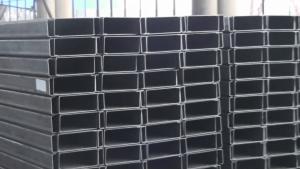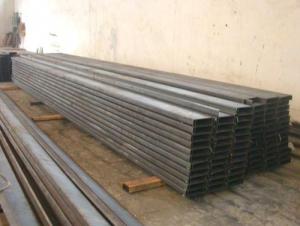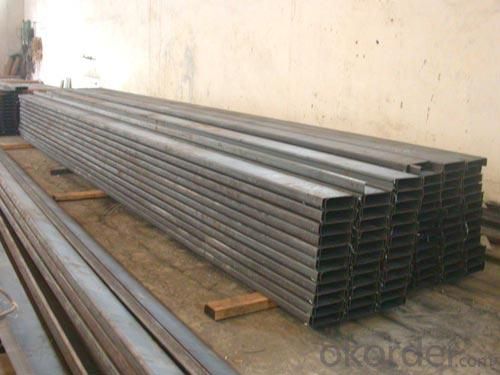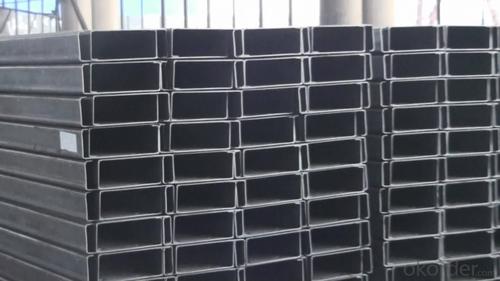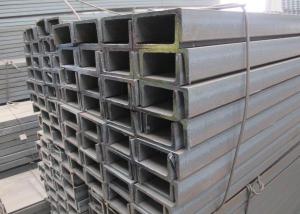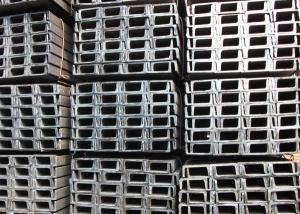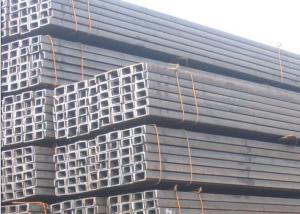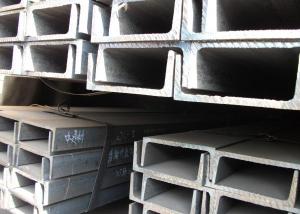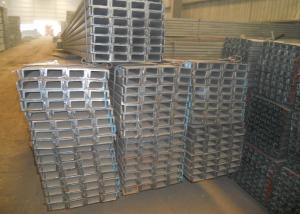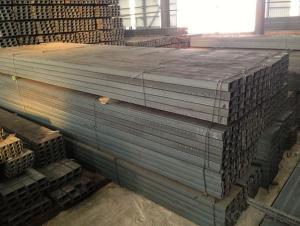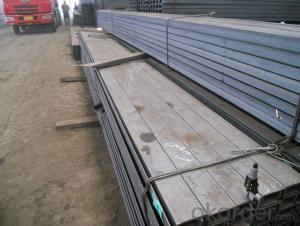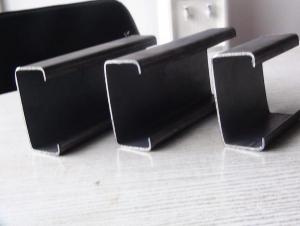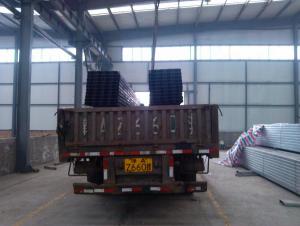Cold-Rolled MS C Channel
- Loading Port:
- Tianjin Port,China
- Payment Terms:
- TT or LC
- Min Order Qty:
- 50MT m.t.
- Supply Capability:
- 1000 Tons Per Month m.t./month
OKorder Service Pledge
OKorder Financial Service
You Might Also Like
Specifications of Cold-Rolled MS C Channel:
1.We supply high quality Cold-Rolled MS C Channel at reasonable price, including Chinese standard, Japanese standard and so on.
Standard | GB/JIS/EN/ASTM/DIN |
Material Grade | Q235B,Q235,Q345,Q345B,SS400,S235JRG1,A36,ST37-2 |
Technique: | Cold Rolled |
Sizes as per chinese standard: |
80×40×20×2.5 - 180×60×20×2.5
|
Sizes as per Japanese standard: |
180×60×20×3 – 300×80×20×3 |
Length: | 6meter, 9meter, 12meter |
Note: we are also competent to provide our customers other Cold-Rolled MS C Channel based on other sizes according to customer’s requirements.
2. The detailed sections of Cold-Rolled MS C Channel as per GB standard.Just as followings in the table-1:
Size | Weight(kg/m) | Size | Weight(kg/m) |
80×40×20×2.5 | 3.925 | 180×60×20×3 | 8.007 |
80×40×20×3 | 4.71 | 180×70×20×2.5 | 7.065 |
100×50×20×2.5 | 4.71 | 180×70×20×3 | 8.478 |
100×50×20×3 | 5.652 | 200×50×20×2.5 | 6.673 |
120×50×20×2.5 | 5.103 | 200×50×20×3 | 8.007 |
120×50×20×3 | 6.123 | 200×60×20×2.5 | 7.065 |
120×60×20×2.5 | 5.495 | 200×60×20×3 | 8.478 |
120×60×20×3 | 6.594 | 200×70×20×2.5 | 7.458 |
120×70×20×2.5 | 5.888 | 200×70×20×3 | 8.949 |
120×70×20×3 | 7.065 | 220×60×20×2.5 | 7.4567 |
140×50×20×2.5 | 5.495 | 220×60×20×3 | 8.949 |
140×50×20×3 | 6.594 | 220×70×20×2.5 | 7.85 |
160×50×20×2.5 | 5.888 | 220×70×20×3 | 9.42 |
160×50×20×3 | 7.065 | 250×75×20×2.5 | 8.634 |
160×60×20×2.5 | 6.28 | 250×75×20×3 | 10.362 |
160×60×20×3 | 7.536 | 280×80×20×2.5 | 9.42 |
160×70×20×2.5 | 6.673 | 280×80×20×3 | 11.304 |
160×70×20×3 | 8.007 | 300×80×20×2.5 | 9.813 |
180×50×20×2.5 | 6.28 | 300×80×20×3 | 11.775 |
180×50×20×3 | 7.536 | ||
180×60×20×2.5 | 6.673 |
Table-1
3. The chemical composition of Cold-Rolled MS C Channel according to Q235B is shown in Table-2.
Alloy No | Grade | Element(%) | ||||
C | Mn | S | P | Si | ||
Q235 | B | 0.12-0.20 | 0.3-0.7 | ≦0.045 | ≦0.045 | ≦0.3 |
Table-2
Note: we are able to present our customers relevant SGS test report for chemical composition of Cold-Rolled MS C Channel.
4. The mechanical property of Cold-Rolled MS C Channel according to Q235B is shown in Table-3-1 and Table-3-2
Alloy No | Grade | Yielding Strength Point(Mpa) | |||
Thickness(mm) | |||||
≦16 | >16-40 | >40-60 | >60-100 | ||
≧ | |||||
Q235 | B | 235 | 225 | 215 | 205 |
Table-3-1
Alloy No | Grade | Tensile Strength(Mpa) | Elongation After Fracture(%) | |||
Thickness(mm) | ||||||
≦16 | >16-40 | >40-60 | >60-100 | |||
≧ | ||||||
G235 | B | 375-500 | 26 | 25 | 24 | 23 |
Table-3-2
Note: we are able to present our customers relevant SGS test report for mechanical property of Cold-Rolled MS C Channel as customer’s request.
Applications of Cold-Rolled MS C Channel:
The Cold-Rolled MS C Channel can be applied to construction of warehouses, workshops, sport stadiums and car parks etc.The hot rolled channel steel belongs to carbon structural steel which is applied to in the field of construction and machinery.In details, the hot rolled channel steel is usually used for arch-itechtural structure, and they could be welded in order to support or hang a vari-ety of facilities. They are also usually used in combination with I beam. Generally,the hot rolled channel steel we supply must possess perfect welding property, riveting property and mechanical property and so on.
Package & Delivery of Cold-Rolled MS C Channel:
1.The hot rolled channel steel will be packed in bundle with steel wire at each end of every bundle and color marking in order to help the customer to recognize his goods more easily at sight.
2. And the hot rolled channel steel could be loaded into 20ft or 40ft container, or by bulk cargo.If the weight of each bundle reaches more than 3.5 mt, the loading by break bulk cargo should be choosed.When the weight of each bundle reaches less than 3mt, the loading by container should be choosed.
3.As for the transportaion from mill to loading port, the truck will be usually used. And the maximum quantity for each truck is 40mt.
4.All in all, we could do in accordance with customer's request.

Production Flow of Cold-Rolled MS C Channel:
1.The steel billet shall be heated in the high temperature furnace.
2. The heated steel billet shall be rolled five to nine times with the aim of shaping the general figure of steel u channel.
3. The hot rolled channel steel should be put onto the cooling bed to make the temperature low.
4. The channel steel should be straighted on the straightener.
5. The straighted channel steel will be cut into meters by saw, as per customer's requirements.
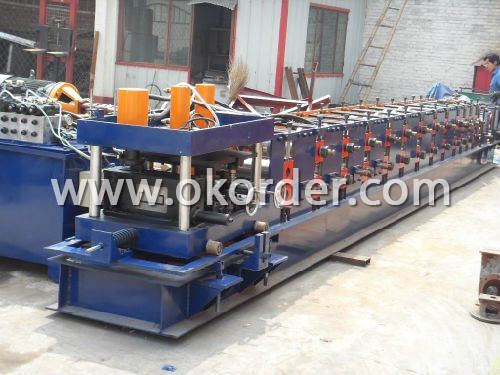
- Q: How do steel channels contribute to seismic resistance?
- Steel channels contribute to seismic resistance in several ways. Firstly, the shape and design of steel channels make them highly resistant to bending and deformation under seismic forces. Their structural integrity helps to maintain the stability and strength of the building during an earthquake. The channels are often used as part of the lateral load resisting system in a building's structure, helping to distribute and dissipate the seismic forces throughout the structure. Additionally, steel channels can be used to reinforce and strengthen other structural elements, such as columns and beams. By adding steel channels to these components, their load-bearing capacity and resistance to seismic forces can be significantly improved. This reinforcement helps to prevent collapse or significant damage to the building during an earthquake. Moreover, steel channels can be strategically placed in a building's frame to create a moment-resisting frame system. This system helps to transfer and distribute the seismic forces throughout the structure, reducing the concentration of forces on specific elements and increasing the overall resistance to seismic events. The use of steel channels in this manner helps to improve the building's overall stability and ability to withstand seismic forces. Furthermore, steel channels can also be utilized in the construction of seismic bracing systems. These systems are designed to absorb and dissipate seismic energy, reducing the impact on the building's structure. By incorporating steel channels into the bracing system, the building's resistance to seismic forces can be significantly enhanced. In summary, steel channels play a crucial role in enhancing a building's seismic resistance. Their shape, strength, and ability to reinforce other structural elements contribute to the overall stability and integrity of the building during an earthquake. By incorporating steel channels into the design and construction of buildings, the risk of damage and collapse due to seismic events can be substantially reduced.
- Q: Are steel channels suitable for historical restoration projects?
- Depending on the project's requirements and objectives, steel channels may indeed be appropriate for historical restoration projects. They possess various advantages that contribute to their popularity in such endeavors. To begin with, steel channels are renowned for their strength and durability. When the original materials of historical buildings have weakened or deteriorated, they can provide structural support and stability. By reinforcing weakened walls, floors, or ceilings, steel channels guarantee the safety and longevity of the restored structure. Furthermore, steel channels can be tailored to mimic the original design and aesthetics of the historical building. They can be shaped and fabricated to replicate decorative moldings or ornamental elements, seamlessly integrating the modern material with the historical structure while preserving its authenticity. In addition, steel channels offer versatility in terms of size and shape, making them suitable for a wide array of restoration projects. They can replace or repair damaged structural elements like beams or columns. Moreover, steel channels can be utilized to create new additions or extensions to historical buildings, maintaining a harmonious balance between the old and the new. Nonetheless, it is crucial to consider the specific guidelines and regulations established by historical preservation organizations or authorities when employing steel channels in restoration projects. These guidelines may stipulate the use of specific materials or techniques to ensure the preservation of historical authenticity. Consequently, consulting with experts in historical restoration and obtaining necessary approvals before incorporating steel channels into a project is essential. To conclude, steel channels possess the qualities of durability, flexibility, and the ability to replicate original designs, making them a fitting choice for historical restoration projects. However, it is vital to give proper consideration to historical preservation guidelines in order to uphold the integrity and authenticity of the restored structure.
- Q: Steel arc bending machine can provide the best what? ` type details
- Determine the maximum section size of the channel, which is related to the power selection of the machine.
- Q: What are the standard sizes for steel channels?
- The standard sizes for steel channels vary depending on the country and industry standards. In the United States, the American Standard Steel Channels (C-shapes) are available in a range of sizes, typically designated by the depth of the channel in inches and the weight per foot. Common sizes include 3x4.1, 3x5.0, 3x6.0, 4x5.4, 4x7.25, and 6x12.5. These sizes are widely used in construction, manufacturing, and structural applications. In other countries, different size standards may be followed. For example, in the United Kingdom, steel channels are often specified using the European standard designation, such as C100x50x10. This designation represents the depth (100 mm), width (50 mm), and weight per meter (10 kg/m) of the channel. It is important to note that these are just a few examples of standard sizes, and there are numerous other sizes available depending on specific requirements and applications. As such, it is recommended to consult relevant industry standards or manufacturers' catalogs for comprehensive information on steel channel sizes.
- Q: What are the cost considerations when using steel channels?
- When using steel channels, there are several cost considerations that need to be taken into account. Firstly, the cost of the steel itself is an important factor. The price of steel can vary depending on factors such as the grade and quality of the steel, as well as market conditions. It is important to consider the cost of the steel channels in relation to the budget and overall project costs. Another cost consideration is the fabrication and installation of the steel channels. Depending on the complexity of the design and the specifications required, the fabrication and installation costs can vary. It is essential to carefully evaluate these costs and ensure they are within the project budget. Additionally, transportation costs should be considered. Steel channels can be heavy and require special handling and transportation. The distance to the project site and the logistics involved in transporting the steel channels can impact the overall cost. Maintenance and durability are also important cost considerations. Steel channels are known for their durability and long lifespan, which can reduce maintenance and replacement costs over time. However, regular maintenance and proper care are still necessary to ensure the longevity of the steel channels. Lastly, it is crucial to consider any additional costs associated with steel channels, such as coatings or finishes. Depending on the application and environmental conditions, certain coatings or finishes may be required to protect the steel from corrosion or other factors. These additional costs should be factored into the overall budget. In conclusion, the cost considerations when using steel channels include the cost of the steel itself, fabrication and installation costs, transportation costs, maintenance and durability, as well as any additional costs associated with coatings or finishes. It is important to carefully evaluate these factors to ensure that the use of steel channels aligns with the project's budget and requirements.
- Q: What is the weight per foot of various steel channel sizes?
- The weight of various steel channel sizes per foot can differ depending on the specific dimensions and thickness of the channel. Steel channels are typically identified by their depth, width, and weight per foot. For instance, a steel channel with a depth of 6 inches and a weight of 8.2 pounds per foot will have an approximate weight of 8.2 pounds per linear foot. Similarly, a steel channel with a depth of 10 inches and a weight of 15.3 pounds per foot will have an approximate weight of 15.3 pounds per linear foot. It is worth noting that these weights are approximate and may slightly vary based on the specific manufacturing process and tolerances. Additionally, different steel alloys or grades may have slightly different weights per foot. Therefore, it is always advisable to refer to the manufacturer's specifications or reference tables for the precise weight per foot of a specific steel channel size.
- Q: How do steel channels contribute to sustainable building practices?
- There are several ways in which steel channels contribute to sustainable building practices. Firstly, these channels are made from recycled materials, with steel being one of the most recycled materials globally, boasting an average recycled content of 90%. By utilizing steel channels, we effectively reduce the demand for new raw materials and conserve precious natural resources. Consequently, this helps to minimize the environmental impact of construction activities. Secondly, steel channels possess exceptional durability and longevity. They boast a high strength-to-weight ratio, meaning that less material is required to achieve the same level of structural integrity when compared to alternative materials. This, in turn, results in reduced material consumption and generates less waste during the construction process. Moreover, the extended lifespan of steel channels means that buildings constructed with these materials require minimal maintenance and repair, thereby reducing the need for additional resources in the future. Moreover, steel channels offer remarkable versatility and can be easily repurposed or reused. When a building reaches the end of its life cycle, salvaging and recycling steel channels contributes to the principles of a circular economy. This, in turn, reduces the quantity of waste sent to landfills while reducing the energy required for the production of new materials. Furthermore, the incorporation of steel channels in construction enables efficient design and construction practices. These channels can be prefabricated off-site, significantly reducing construction time and minimizing disruption to the surrounding environment. Additionally, the lightweight nature of steel channels facilitates easier transportation, thereby reducing carbon emissions associated with transportation and logistics. In conclusion, steel channels play a vital role in sustainable building practices by promoting resource conservation, waste reduction, and energy efficiency. Their recyclability, durability, and versatility make them an environmentally friendly choice for construction projects, ultimately contributing to the development of a greener and more sustainable built environment.
- Q: How do steel channels contribute to the overall stability of a building?
- Steel channels contribute to the overall stability of a building in several ways. Firstly, they provide structural support and reinforcement to the building's framework. Steel channels are typically used as beams or columns, which help distribute the weight of the building and resist bending or buckling under load. This added strength and rigidity ensure that the building can withstand various external forces and remain structurally stable. Additionally, steel channels enhance the building's resistance to lateral forces such as wind or earthquakes. By strategically placing steel channels at key locations within the building's framework, they can act as bracing elements, effectively transferring and dissipating these lateral forces. This helps to minimize the building's deflection, sway, and potential damage during high winds or seismic events. Moreover, steel channels play a crucial role in supporting the building's floor and roof systems. They serve as primary load-bearing elements for carrying the weight of these components and transferring it to the building's foundation. This ensures that the floors and roofs remain level, preventing any sagging or collapsing that could compromise the stability of the entire structure. In addition to their structural contributions, steel channels also offer benefits in terms of versatility and cost-efficiency. They are available in various sizes and shapes, allowing for customization and adaptation to different architectural designs and construction requirements. Furthermore, steel channels are durable and have a high strength-to-weight ratio, making them a cost-effective choice for enhancing the stability of a building. Overall, steel channels are indispensable components in modern construction, as they provide essential structural support, enhance resistance to lateral forces, support floor and roof systems, and offer versatility and cost-efficiency. By incorporating steel channels into the building's design and construction, engineers can ensure that the overall stability and integrity of the structure are significantly improved.
- Q: Can steel channels be used for HVAC duct supports?
- Indeed, HVAC duct supports can utilize steel channels. Due to their robustness and durability, steel channels prove to be an ideal choice for furnishing structural reinforcement to HVAC ducts. The installation process is hassle-free, and they furnish the ductwork with stability and rigidity. Moreover, steel channels possess the ability to sustain the weight of both the ducts and any supplementary equipment affixed to them, thereby ensuring the optimal operation of the HVAC system.
- Q: Is it better to cast a pipe or a channel steel?
- Usually with steel and wood structure, the top of the following floor should be suspended with plasterboard. Many students react gypsum suspended ceiling time will crack. This is because, no matter how good the steel is bought, there will always be some deformation, especially in the middle of the house. Lead to the deformation and cracking of the gypsum board close to the steel frame.
1. Manufacturer Overview
| Location | Tianjin,China |
| Year Established | 2006 |
| Annual Output Value | Above US$ 500 Million |
| Main Markets | China; Middle East; Southeast Asia; South America |
| Company Certifications |
2. Manufacturer Certificates
| a) Certification Name | |
| Range | |
| Reference | |
| Validity Period |
3. Manufacturer Capability
| a) Trade Capacity | |
| Nearest Port | Tianjin |
| Export Percentage | 40%-60% |
| No.of Employees in Trade Department | 11-20 People |
| Language Spoken: | English; Chinese |
| b) Factory Information | |
| Factory Size: | Above 50,000 square meters |
| No. of Production Lines | Above 3 |
| Contract Manufacturing | materials for processing; OEM Service Offered |
| Product Price Range | Average |
Send your message to us
Cold-Rolled MS C Channel
- Loading Port:
- Tianjin Port,China
- Payment Terms:
- TT or LC
- Min Order Qty:
- 50MT m.t.
- Supply Capability:
- 1000 Tons Per Month m.t./month
OKorder Service Pledge
OKorder Financial Service
Similar products
Hot products
Hot Searches
Related keywords
